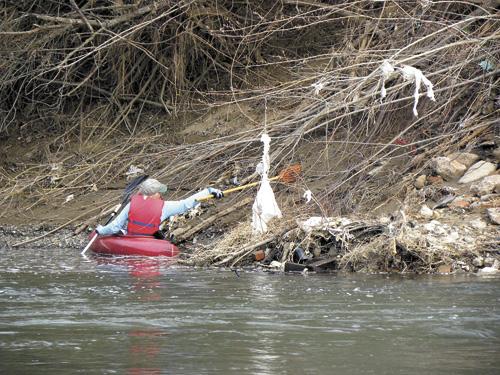I counted about 200 seals hauled out on the beach at Jenner one
grey afternoon last week.
It was an overcast Monday with not much wind or surf. Pelicans
and seagulls bobbed in the Russian River where it flowed past a
sandbar into the Pacific Ocean.
A german couple with a young boy stopped their car on the
Highway 1 bluff above the estuary and took pictures with their cell
phones. I learned the German word for “wow” is “wow.”
This idyllic scene may disappear, some people fear, when the
Sonoma County Water Agency begins implementing a plan to keep the
sandbar mostly closed in the summer.
The Estuary Management Project, as it’s called, is ironic
because it’s meant to help the river’s endangered fish survive yet
it’s also worrying estuary watchers such as Norma Jellison who say
it ignores the well-being of other species including the many
humans who flock to the Sonoma Coast to see the river flow into the
sea and photograph the harbor seals hauled out on the shore.
“There are many eyes on this estuary project because it is
beloved by so many,” said Jellison last week at a public hearing on
the estuary project’s environmental impact report. “There are very
major impacts of this on the public trust.”
The Water Agency agrees. The estuary plan and another major
proposed Russian River change called the Fish Flow Project are both
part of a National Marine Fisheries Service (NMFS) mandate telling
the Sonoma County Water Agency and the U.S. Army Corps of Engineers
to change the way they operate in the Russian River mainly by
reducing the amount of water flowing in the summertime.
Possible effects of reduced summer flow on the river’s water
quality have been closely watched since NMFS three years ago issued
a Biological Opinion that river summer flows need to be cut to help
the survival of chinook and coho salmon and steelhead trout.
Both projects are supposed to improve river habitat for
anadromous fish and both have aroused the suspicion of river lovers
of every stripe.
As might be expected there are as many theories on what’s
affecting Russian River water quality as there are anglers,
swimmers and boaters.
The lower Russian River was statistically cleaner this summer
but no one is sure why. Two wet-weather years in a row with plenty
of late spring rain left more water in the river and tributaries,
and the sandbar at the mouth never closed.
Whether closing the barrier beach necessarily elevates bacteria
levels upstream, as some predict, “is something that really hasn’t
been determined,” said Jeff Church of the Sonoma County Water
Agency .
“There are a lot of variables involved,” said Church, regarding
water quality particularly from the estuary to Monte Rio, the
section of river where a deeper lagoon at Jenner could affect
flow.
Weather plays a large part too, as does the level of
recreational use and the timing of summer dam installations, said
Church. And this year there was a lot of water.
In late July the Russian River was flowing at more than 160
cubic feet per second (cfs) at the Hacienda Bridge, more than twice
the required minimum flow.
Between Healdsburg and Windsor it was flowing at more than 200
cfs on Aug. 18, the nominal end-of-the-season date when school
starts.
The required minimum instream flow is normally 125 cfs in the
lower river but this year it’s only 70 cfs under the terms of a
temporary state permit that’s been granted to the Sonoma County
Water Agency for the past three summers. The Fish Flow Project
would keep it at 70 cfs every year there’s normal rainfall.
Hulbert Creek west of Guerneville was still flowing last week.
Clear water rippled across the fine gravel where the creek passes a
couple of rusty Nash Ramblers embedded in the redwoods and
blackberry bushes.
Let’s face it: a boat trip down the Russian River is not exactly
a wilderness trek. People who paddle down the river and live to
tell about it praise its natural beauty as well as its human
abuse.
The annual river cleanup next month on Sept. 24 and 25 will
undoubtedly drive the point home. Last year more than 300
participants cleared more than 55 miles of river between Cloverdale
and Duncan’s Mills. They hauled out 182 tires, 1,860 pounds of
glass, aluminum, cardboard, and other recyclables, nearly 12 tons
of metal and 3,920 pounds of household trash and other non-natural
items such as patio chairs, televisions, computer monitors,
mattresses, auto batteries and used motor oil.
We don’t know how a lot of stuff gets in the River but we do
know that a lot of people are watching. Stream gauges are
everywhere telling us how the river does. Is it deep? Dry?
polluted? Or not?
You can track the rate of flow on your laptop or smart phone. At
Guerneville’s King’s Sport and Tackle kayak rental shop it only
takes store manager Nick Wheeler a fraction of a second to flick up
a chart on his phone showing the River’s summer flow trend.
“It’s dropped in the last two weeks,” said Wheeler, indicating
a descending blue state Water Resources Control Board flow chart on
his phone. “Before that it was wonderful.”
The river stayed above 150 cfs all summer between Steelhead
Beach and Guerneville until paddlers recently started complaining
“about dragging their boats and all the moss,” said Wheeler.
Otherwise its been a good year. “All that spring rain,” said
Wheeler. “The dams are full. Austin Creek has been running steady
all hear. That’s wonderful. That’s good for the fish.”
Wheeler says there’s little doubt the summer closure of the
estuary could affect water quality all the way upstream to Vacation
Beach, particularly in a dry year.
“Monte Rio hasn’t been posted once this year,” said Wheeler,
referring to county Health Department swimming advisories posted at
public beaches when bacteria counts exceed state guidelines.
“That’s because the mouth hasn’t closed,” said Wheeler.
Johnson’s Beach in Guerneville last weekend was sunny, crowded
and pleasant. Rental canoes and kayaks were lined up neatly on the
sand. There was a long line of people at the snack bar.
“We’ve had a wonderful summer,” said Clare Harris who with his
family has been operating the summer concession at Johnson’s Beach
since the 1960s.
“People aren’t traveling, said Harris. “Everyone’s hungry for
recreation, but it costs $100 to drive to Reno.”
Hence the influx to Johnson’s Beach, a safe and clean place on
the river with a kiddie pool, $2 hamburgers and a calm green
expanse of water backed up behind the summer dam.
There were no bacteria warnings at Johnson’s this summer either,
a contrast with two year years ago when the beach was posted
several times by the county health department.
In 2009 there were more than 90 exceedances of health guidelines
in the River between Cloverdale and Jenner. “It was like nothing
we’ve ever seen,” said a NMFS biologist.
The summer of 2009 followed three years of drought-like
conditions and had officials worried that Lake Mendocino would run
dry.
Harris and others in the river recreation business see a
definite correlation between flow levels and bacteria counts.
“This year the reservoirs are full,” said Harris. “We’ve been
lucky.”
River sampling ramps up
This summer the Sonoma County Water Agency is sampling the River
for a lot of things including temperature, dissolved oxygen levels,
acidity (pH), nutrients, bacteria and algae.
A report is due out in March next year on what this summer’s
monitoring reveals. The testing is in connection with the managed
estuary plan and another flow-change proposal called the Fish Flow
Project that would reduce the required minimum summer flow from 125
cfs to 70 cfs between Healdsburg and Jenner.
As part of these efforts the Water Agency plans to establish a
water quality baseline in the River from Monte Rio to the
estuary.
Here’s what the want to find out:
•What are the background levels of nutrients and pathogens under
the current minimum instream flow levels? How do these background
levels respond to changes in instream flow, considering other
contributing factors?
•Does water temperature and dissolved oxygen respond to changes
in minimum instream flows?
•Are there secondary biological effects related to changes in
water quality related to instream flow changes (e.g. stress to
fish, plants, invertebrates) and if so, what are they? Effects to
public health/recreation?
•What are the background levels of nutrients and pathogens in
the estuary? How do the levels respond to managing the estuary as a
closed summer lagoon, considering other contributing factors?
•Do water temperature, dissolved oxygen, and salinity respond to
managing the estuary as a closed summer lagoon?
49.8
F
Healdsburg
April 30, 2025









